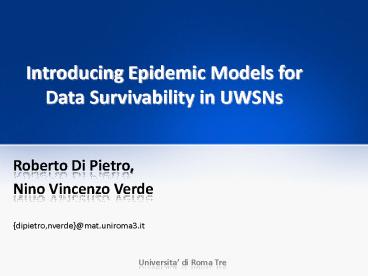Roberto Di Pietro, - PowerPoint PPT Presentation
1 / 22
Title:
Roberto Di Pietro,
Description:
Introducing Epidemic Models for Data Survivability in UWSNs {dipietro,nverde}_at_mat.uniroma3.it RoadMap UWSNs Epidemic Models SIR SIS Epidemic Models for Information ... – PowerPoint PPT presentation
Number of Views:156
Avg rating:3.0/5.0
Title: Roberto Di Pietro,
1
Introducing Epidemic Models for Data
Survivability in UWSNs
- Roberto Di Pietro,
- Nino Vincenzo Verde
dipietro,nverde_at_mat.uniroma3.it
Universita di Roma Tre
2
RoadMap
- UWSNs
- Epidemic Models
- SIR
- SIS
- Epidemic Models for Information Survivability in
UWSNs - Modeling the problem
- Applications
- Results
- Conclusions
3
Unattended WSNs
- Sporadic presence of the sink
- Sensors upload info as soon as the sink comes
around - Applications
- Hostile environment
- monitoring
- Pipeline monitoring
4
Information Survivability
- Sink not always available
- More subject to malicious attacks than
traditional WSN - Our target
To provide a certain level of assurance about
Information Survivability
5
Epidemic Models
- Stochastic approaches
- Accurately describe fluctuation
- Variation chance in exposure risk
- Very complex
- Laborious to set up
6
Epidemic Models
- Deterministic approaches
- Describe the dynamic of a disease at the
population scale - Fits very large populations
- Not accurate with small populations
Are they accurate when trying to minimize energy
consumption?
7
Deterministic Epidemic Models
- n individuals are partitioned into several
compartment - Transition probabilities between any two
compartments are given - The spreading of the disease is taken into
consideration
8
SIR
S
I
R
Susceptibles
Infected
Recovered
- It does not admit a generic analytic solution,
but
Is the basic reproduction number if gt
1/s(0) then Epidemic outbreak
9
SIS
- Solution
- Using i(t) it is possible to predict the number
of sick individuals at time t
10
Modeling the Information Spread
- n sensors, 1 sink, 1 attacker
- A secure routing protocol allows to exchange
information between any pair of sensor - Evolution time partitioned in rounds
- Both sensors and the attackers play their game
11
Sensors Model
- Data is transmitted by replication
- Each sensor that stores the datum transmits it
with probability to each neighbor - Theorem
If i is the fraction of sensors possessing the
datum, and if each sensor forwards the datum with
probability a/n , the value sia is an
approximation of the probability that the datum
reaches a sensor that do not possess it.
12
Proof
sia
?
a/n is close to 0 -gt using the binomial
approximation the above formula is equal to asi
13
Attacker Model
- We consider 2 attackers
- ADVsimple
- It is able to destroy each sensors containing the
datum with probability ß in each time step - ADVstealth
- It is able to erase the datum without destroying
the sensor - It does not change the behavior of the sensor
14
Epidemic models in UWSNs
ADVsimple
Replication a/n
SIR
ADVstealth
Replication a/n
SIS
15
SIR Test
- a0.605
- ß0.5
- n100
- i(0)0.1
16
SIS Test
- n100
- i(0)0.1
17
Outcome
- Epidemic models can be used to forecast the
behavior of an UWSNs - It becomes easy to set-up the parameters
- It is possible to study the conditions that have
to be satisfied to assure information
survivability - Problems?
- Energy Consumption it is needed to minimize the
replication process
18
Minimizing Energy Consumption
- In both the models energy consumption is
minimized when i(t) is close to 0 for any t - Statistical fluctuation can force the system to
loose the datum
n100 i(0)0.01
n100 i(0)0.05
19
Video Simulation SIS
n100 a0.22 ß0.2
Steady state when i(t)(1-ß/a)
Is the information survivability assured?
20
Conclusions
- Deterministic epidemic models can be used to
model information assurance in UWSNs - The parameters that assure the survivability are
easy to set up - They fit very well large sensor networks
- Unlikely events can induce the loss of the datum
- It is needed to assess bounds on the probability
of these events
21
Questions?
Thank you!
22
Some Related Work
- R. Di Pietro, and N. V. Verde. Epidemic data
survivability in Unattended Wireless Sensor
Networks. In Proceedings of the ACM Conference on
Wireless Network Security (WiSec), Hamburg,
Germany, June 2011. - Michele Albano, Stefano Chessa, and Roberto Di
Pietro. A model with applications for data
survivability in Critical Infrastructures.
In Journal of Information Assurance and Security,
vol. 4(6), pages 629-639, June 2009. - Roberto Di Pietro, Luigi V. Mancini, Claudio
Soriente, Angelo Spognardi, and Gene Tsudik.
Catch Me (If You Can) Data Survival in
Unattended Sensor Networks. In Proceedings of
the 6th IEEE International Conference on
Pervasive Computing and Communications (PerCom
2008), pages 185-194, Hong Kong, March 17-21,
2008. - Roberto Di Pietro, Luigi V. Mancini, Claudio
Soriente, Angelo Spognardi, and Gene Tsudik.
Playing Hide-and-Seek with a Focused Mobile
Adversary in Unattended Wireless Sensor
Networks. In Journal of Ad Hoc
Networks (Elsevier) - Special Issue on Privacy
and Security in Wireless Sensor and Ad Hoc
Networks -, vol. 7(8), pages 1463-1475, November
2009.































